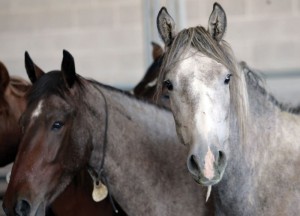For immediate release:
Is it safe to use pesticides on an indigenous species?
WASHINGTON (June 7, 2013)–In light of the National Academy of Sciences (NAS) report on wild horses and burros lacking data for an overpopulation claim, Protect Mustangs calls upon Secretary Jewell for an immediate halt to roundups and to return the 50,000 wild horses in government holding to the more than 30 million acres of herd management areas in the West to reduce costs quickly. The native wild horse conservation group calls on the Department of Interior to acknowledge wild horses are native, implement holistic land management and reserve design thus creating a win-win for wild horses to help the ecosystem and reverse desertification. Protect Mustangs requests that ‘survival of the fittest’ should be the only form of fertility control considered because indigenous wild horses must not become domesticated on the range. Artificial management such as pesticides and sterilizations should never be used on a native species such as Equus caballus.
“With the gluttony of roundups and removals, wild horses reproduce at a higher rate to prevent extinction,” explains Anne Novak, executive director of Protect Mustangs. “We need more studies to establish what the normal reproduction rate is and discover truths about alleged overpopulation on the more than 30 million acres of public wildlands designated for their use. Today there is no scientific proof of overpopulation to merit fertility control.”
In July 2010, Raul Grijalva (D-AZ) spearheaded a letter signed by members of Congress, requesting an investigation of the Wild Horse and Burro Program by the National Academy of Sciences. This was a direct result of public outcry and media exposure of roundup carnage. Three years later, the NAS report was released last Wednesday.
According to a press release from NAS released Wednesday, “The U.S. Bureau of Land Management’s (BLM) current practice of removing free-ranging horses from public lands promotes a high population growth rate, and maintaining them in long-term holding facilities is both economically unsustainable and incongruent with public expectations, says a new report by the National Research Council.”
“Making decisions to apply a fertility drug to wild horse herd mares would put wild horse herds in danger of a die-off if any natural or manmade disaster struck the herd management area–be it wildfire, an extreme winter, mass predation or something else,” explains Kathleen Gregg, environmental researcher. “If a majority of the mares are non-reproducing and thus zero or even just a few births, then it is easy to see that the entire herd would be in jeopardy, both genetically and physically, and would diminish their ability to survive into the future. Then we have a herd that is not safe on its own range. Wild horses must to be protected as the law states they shall be.”
“Unfortunately, the Academy quickly recommends fertility control as a better solution without considering the ‘do nothing’ or ‘placebo’ option which is an integral component of every credible field trial for pharmaceutical and other ‘treatment’ plans,” states Carl Mrozek, filmmaker of Saving Ass in America. “Had they searched for examples of herds with minimal or no culling in the past decade or so, they would have found multiple examples of herds which appear to have achieved homeostasis (equilibrium) or something approaching it, naturally, without BLM roundups or fertility treatments.”
“The NAS findings clearly state that the BLM has failed to provide accurate estimates of the nation’s population of wild horses and burros,” states Jesica Johnston, environmental scientist and biologist. “Therefore, the NAS cannot conclude that a state of over-population exists and or provide a recommendation for artificial management considerations such as ‘rigorous fertility controls’ to control populations for which the complex population dynamics are currently unknown.”
Recently fertility control, in the form of immunocontraceptives for wild horses, was erroneously passed by the EPA as “restricted use pesticides”. The EPA inaccurately named indigenous wild horses “pests” in order to pass the drug. Pesticides (PZP, GonaCon®, etc.) should never be used on native species such as E. caballus.
“PZP and other fertility control should not be used on non-viable herds either,” states Debbie Coffey, director of wild horse affairs at Wild Horse Freedom Federation. “Most of the remaining herds of wild horses are non-viable. The NAS and any advocacy groups that are pushing PZP and other fertility control have not carefully studied all of the caveats in Dr. Gus Cothran’s genetic analysis reports along with the remaining population of each herd of wild horses.”
Equus caballus originated in North America more than 2 million years ago. Equus survived extinction through migration and E.caballus could have returned to America with the Spanish unless some had remained on the continent the entire time. Today researchers question historical records–written with Inquisition censorship–that claim the Spanish brought the first horses to America. Even so, if no horses remained when the Conquistadors arrived they would not be introducing the species but “returning” E.caballus to its native land.
“It’s time for land managers to come out of the dark ages–use native wild horses to heal the land and reverse desertification,” states Novak. “We’d like to see the BLM manage the land using wild horses as a resource in partnership with the New Energy Frontier–at virtually no cost to the taxpayer.”
In 1900 there were 2 million wild horses roaming in freedom in America. Today native wild horses are underpopulated on the range. Advocates estimate there are less than 18,000 left in the ten western states combined.
Protect Mustangs is a conservation group devoted to protecting native wild horses. Their mission is to educate the public about the indigenous wild horse, protect and research American wild horses on the range and help those who have lost their freedom.
# # #
NAS Study Review
Media Contacts:
Anne Novak 415.531.8454 Anne@ProtectMustangs.org
Kerry Becklund, 510-502-1913 Kerry@ProtectMustangs.org
Links of interest:
Washington Post: Independent panel: Wild horse roundups don’t work; use fertility drugs, let nature cull herds http://www.washingtonpost.com/national/energy-environment/independent-panel-to-recommend-changes-in-blm-wild-horse-program/2013/06/05/b65ba772-cdb3-11e2-8573-3baeea6a2647_story.html
Congressional letter requesting an NAS investigation: https://docs.google.com/viewer?a=v&pid=sites&srcid=ZGVmYXVsdGRvbWFpbnxhbWVyaWNhbmhlcmRzNHxneDo1ZTFlMDQ1MzY4MzZiMzI3&pli=1
Information on native wild horses: http://protectmustangs.org/?page_id=562
NAS Press release June 5, 2013: http://www8.nationalacademies.org/onpinews/newsitem.aspx?RecordID=13511
NAS Report: Using Science to Improve the BLM Wild Horse & Burro Program: A Way Forward http://www.nap.edu/catalog.php?record_id=13511
Sacramento Bee, Panel: Sterilize wild horses to cut population Read more here: http://www.sacbee.com/2013/06/06/5475171/study-sterilize-horses-to-drop.html#storylink=cpy
GonaCon press release spins wild horse overpopulation myths: http://www.aphis.usda.gov/newsroom/2013/02/horse_vaccine_approval.shtml
ZonaStat-H EPA Pesticide Fact Sheet: http://www.epa.gov/pesticides/chem_search/reg_actions/pending/fs_PC-176603_01-Jan-12.pdf
Princeton University: Wildlife and cows can be partners, not enemies, in the search for food http://www.princeton.edu/main/news/archive/S32/93/41K10/index.xml?section=featured
Gone viral~ The Associated Press, March 24, 2013: Budget axe nicks BLM wild-horse adoption center http://www.denverpost.com/colorado/ci_22862206
US property exposed to wildfire valued at $136 billion says report: http://www.artemis.bm/blog/2012/09/17/u-s-property-exposed-to-wildfire-valued-at-136-billion-says-report/
KQED Horse fossil found in Caldecott Tunnel: http://science.kqed.org/quest/2011/05/26/new-fossils-from-the-caldecott-tunnel/
Horseback Magazine: Group takes umbridge at use of the word “feral” http://horsebackmagazine.com/hb/archives/19392
Protect Mustangs in the news: http://protectmustangs.org/?page_id=218
Protect Mustangs’ press releases: http://protectmustangs.org/?page_id=125














